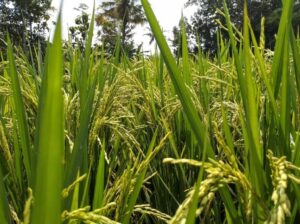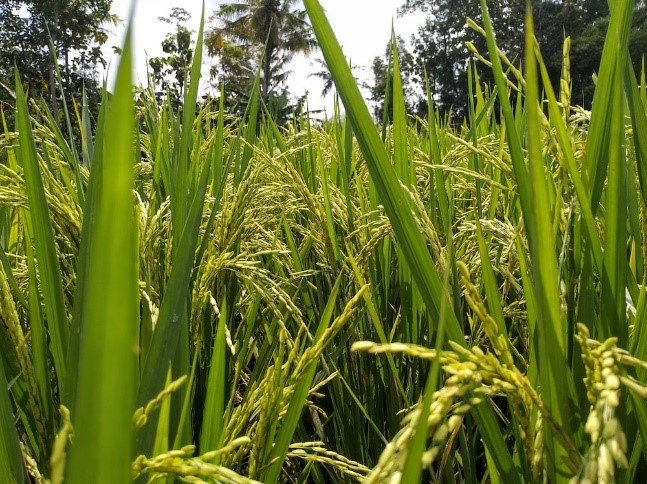The effectiveness of cultivating hybrid rice hinges on the triumphant execution of the hybrid rice seed production initiative, facilitating the cost-effective production of top-tier seeds. Specialized methodologies are imperative for hybrid rice seed production, demanding a comprehensive grasp among the production personnel. The utilization of the three-line system in hybrid rice seed production, employing the A line (female), B line (maintainer), and R line (restorer) – encompasses a threefold process:
- Multiplication of A line

- Multiplication of B and R lines
- Production of hybrid seed (A x R)
Attaining superior quality F1 seeds within the hybrid seed production scheme mandates a fundamental requirement: the elevated genetic and physical purity of the parent lines. Even a minute level of impurity or contamination present in a parental line can result in the rejection of seed production plots. The presence of even slight impurities in parent lines can give rise to substantial expenses due to the extensive measures required for elimination, a process that can significantly impact the budget of hybrid seed producers. The existence of impurities within parental lines contributes to variations in plant characteristics such as type, growth duration, height, and grain size, ultimately exerting a negative influence on the overall quality of the F1 hybrid.
Selection of land
When choosing land for seed production purposes, it’s essential to opt for fertile soil, preferably of a light texture, coupled with ample irrigation and an effective drainage system. The chosen field should be devoid of weeds and any unintended plants that might have originated from the prior paddy crop. To ensure a consistent flowering pattern, a uniform plot with a level terrain is necessary. The field must remain unharmed by severe pests and diseases. For hybrid rice seed production areas, it’s crucial to maintain isolation due to the capacity of rice pollen to travel extended distances through the wind. Overlooking this aspect can lead to impurities in the resulting F1 seeds. While selecting land for isolation, the following factors must be taken into account:

Space isolation
Maintaining a spatial isolation of at least 100 meters between seed production plots and other rice varieties typically proves sufficient for ensuring high-quality hybrid seed production. However, for the multiplication of male sterile (A line) plants, it’s advisable to employ a safer isolation distance of up to 200 meters. Meanwhile, when it comes to multiplying B and R lines within varieties, an isolation gap ranging from 3 to 5 meters is satisfactory.
Time isolation
In cases where spatial isolation isn’t feasible, temporal isolation of approximately 30 days proves to be an effective alternative. This implies that the flowering period of the parent lines within the seed production field should differ by a minimum of 30 days, either preceding or following the flowering period of other varieties cultivated in the vicinity. This temporal offset prevents the risk of pollen contamination.
Barrier isolation
Tall and densely grown trees, shrubs, or certain lofty crops like sorghum, pigeon pea, and sugar cane, placed at intervals of 30-40 meters, can function as effective barrier isolators. However, it’s crucial to emphasize that spatial isolation remains the paramount factor to prioritize when aiming for the production of superior-quality seeds.
Seeding time
Scheduling the seeding of parental lines should be strategically orchestrated to align their flowering stages with the optimal climatic conditions outlined as follows:
- Daily average temperature ranging from 24°C to 30°C
- Relative humidity maintained between 70% and 80%
- Day-to-night temperature differentials spanning 8°C to 10°C
- Abundant sunshine accompanied by gentle wind patterns
- Absence of uninterrupted rainfall lasting for three consecutive days during the flowering phase
- These prerequisites align well with the conditions prevalent in the dry season.
Nursery bed preparation and sowing
Due to the substantial expense associated with seeds, it is imperative to cultivate the nursery within a meticulously maintained field in order to yield vigorous and disease-free seedlings. Employing the ideal seed rate and ensuring the full utilization of every seed through effective nursery management practices is essential. A well-spaced and adeptly managed nursery results in the production of robust seedlings for transplantation into the primary field. The conventional recommendation entails employing 1 kg of parental line seed across an expanse of 40 m². For cultivating a main field spanning 1 hectare, the requisite quantities comprise 12.5 kg of A line seed and 5 kg of R line seed.
Staggered sowing of parental lines for flowering synchrony
The successful formation of hybrid seeds in the female line is primarily contingent upon achieving synchronized flowering with the R line. Therefore, the planting schedules for both male and female lines must be meticulously coordinated to attain this goal. For instance, when the male line’s flowering duration exceeds that of the female line by 10 days, staggered sowings of the male line are executed, ensuring a consistent supply of pollen. In such scenarios, the R line is sown three times (13, 9, and 5 days ahead of the female line) to secure the necessary pollen availability. Nonetheless, in countries like China, where the technique has been finely honed, only one or two sowings of the male line suffice.
Transplanting
For conventional high-yielding varieties, transplantation is typically initiated once the nursery crop reaches an age of 25 to 30 days. However, in the context of hybrid seed production plots, transplantation can commence within a range of 21 to 35 days, contingent upon the disparity in duration between the A and R lines. This well-timed transplantation practice ensures optimal harvesting of parental lines. Transplanting seedlings that are either too young or excessively mature can disrupt the flowering timeline and impact the number of tillers. During the process of uprooting from the nursery and the subsequent transplantation, special attention should be paid to prevent the intermixing of seedlings belonging to male and female parentages. Additionally, care must be taken to avoid the mingling of seedlings of different ages from the male parent, as this could disrupt the even distribution and availability of pollen. To attain coherent flowering synchronization, it is advisable to transplant the longer-duration parental line first. Transplanting R lines: 
- Planting in paired rows with a 15 cm gap between individual plants.
- Transplanting seedlings of varying ages in a consecutive sequence (such as I, II, III, followed by another round of I, II, III).
- Placing a solitary seedling per mound, with a row-to-row separation of either 15 or 30 cm in accordance with guidelines, within the primary field.
Transplanting A lines
- The standard practice in numerous Asian countries involves six rows, each with a 15 cm gap between the paired rows of R line seedlings.
- For each mound, a single seedling is placed, with a spacing arrangement of 15 cm by 15 cm.
- In India, a gap of 30 cm between rows of A line and R line is employed to encourage robust male growth and enhance pollination. Conversely, in China, the A-to-R row ratio fluctuates between 2:8 and 2:14.
Row ratio, spacing and direction
Accumulated years of expertise in hybrid rice seed production underscore the significant influence of row ratios and spacing. The arrangement of seed parents and pollen parents with distinct row ratios and specific intervals exerts a considerable impact on seed yield outcomes. A row ratio of 6:2, designating six rows for seed parents and two rows for pollen parents, has demonstrated exceptional effectiveness. Orienting the rows perpendicular to the prevailing wind direction during the flowering stage facilitates the effortless dispersion of pollen onto the seed parent plants.
Ideal synchronization
To achieve the best synchronization of flowering, it is recommended that the female parent undergoes flowering 2-3 days ahead of the male parent.
- When both A and R lines share identical growth durations, the A line’s flowering should precede the R line by 1-2 days throughout all stages of panicle development.
- In instances where the A line has a shorter duration compared to the R line, the R line should attain its flowering stage one phase ahead of the A line during the initial three stages of panicle development.
- If the A line’s growth duration surpasses that of the R line, the A line should initiate flowering 2-3 days earlier than the R line within the initial three stages of panicle development.
Adjustment of flowering
In cases where the projected difference in flowering spans more than 3 days between the parent lines, efforts should be undertaken to synchronize their flowering. The introduction of rapidly releasing nitrogen fertilizers onto the parent displaying early development during the initial phases of panicle growth tends to postpone the flowering process. Similarly, the application of a phosphatic solution (1%) onto the parent that tends to flower later can expedite flowering by approximately 2-3 days. When the pollen parent (R line) exhibits a tendency to initiate heading earlier than the seed parent (A line) following the third stage of panicle inception, strategically placing nitrogen fertilizer in the root zone proves advantageous in retarding the progression of panicle development.
Leaf clipping
Trimming the leaves of both the A and R lines proves beneficial in promoting improved out-pollination and seed set. When the flag leaf is elongated and stands upright, it could impede the efficient dispersal of pollen from the R to the A line, consequently impacting the rate of outcrossing. In scenarios where this interference is observed, it is recommended to remove the flag leaves while the primary stems are still in the boot leaf stage. This practice of flag leaf clipping contributes to the even dissemination of pollen across A line plants, enhancing pollination uniformity. However, it is not advisable to engage in leaf clipping within regions where diseases like bacterial leaf blight, sheath blight, and bacterial leaf streak are prevalent. Such actions could potentially facilitate the spread of these diseases, resulting in diminished seed yield.
Use of GA3
GA3 is utilized to enhance the extension of panicles. In female lines featuring WA cytoplasm, panicle exertion tends to be inadequate or incomplete. The application of GA3 through spraying serves to facilitate panicle exertion and offers additional benefits, including the prolongation of floret opening, enhancement of stigma exertion and receptivity, as well as the expansion of the flag leaf angle. The use of GA3 spray contributes to a height increase of 10-15 cm and can be employed to adjust the plant height, particularly concerning the R line in relation to the A line. In India, an optimal dose of 50 g GA3/ha has been determined (30 g GA3 sprayed at 5-10% heading, followed by an additional 20 g GA3 sprayed one day later, with a 1-day interval between the two applications). When the male line does not surpass the female line in terms of height, an additional dose of GA3 is recommended for the R line to elevate its stature. Preferably, GA3 should be sprayed during the evening hours (between 3:00 PM to 6:00 PM) and on days with abundant sunlight.
Supplementary pollination
Rice is fundamentally a crop that primarily undergoes self-pollination. The implementation of supplementary pollination aims to amplify the rate of outcrossing, ultimately enhancing the seed set. This process involves inducing additional pollination by gently agitating the pollen parent using ropes or sticks, facilitating the efficient dispersion of pollen onto A line plants. To achieve optimal results, supplementary pollination should be executed at intervals of 20 to 30 minutes, repeated 3-4 times. This practice is sustained over a span of 10-12 days during the flowering phase. By adopting improved parental management practices coupled with effective supplementary pollination, there is a considerable potential for a substantial increase in hybrid seed yield.
Roguing
Ensuring the purity of hybrid seeds takes precedence in the quest for superior seed production. To attain both genetic and physical purity, the process of roguing must be rigorously undertaken at various stages. Roguing involves the elimination of undesired rice plants from both parent groups, including male and female lines. Among these undesirables are off-types, such as maintainer or B-type plants within the A line. Detecting off-type plants is feasible by observing their morphological attributes like height, leaf dimensions, leaf structure, coloration, panicle characteristics, size, and pigmentation during the advanced vegetative or early flowering phases. B line plants that share morphological similarities with A line plants can be recognized by their well-developed anthers, fully extended panicles, and an earlier flowering timeframe by 3-4 days compared to the A line. Any such plants found within the A line row should be promptly uprooted upon identification. Roguing performed at the right juncture, typically at the initiation of flowering, guarantees the preservation of seed quality. This crucial process is typically executed from the vegetative growth phase up to the onset of flowering.
Seed Production of a Line
In the nucleus seed production phase of the A line, the original breeder employs controlled hand-crossing between authentic A/B plants. During the breeder seed production stage of the A line, breeder plants are arranged in a 2:2 ratio of female to male rows, with a substantial isolation distance of at least 200 meters. Vigilant roguing activities are conducted at multiple growth stages, spanning from vegetative growth to the harvest phase, to ensure the plot’s integrity. During the foundation seed production of the A line, the process is overseen by an expert in foundation seed production. Seedlings are planted in a ratio of 4 female rows to 2 male rows, while maintaining a minimum isolation distance of 150 meters. This stage often involves two separate sowings of the male line, with the B line being sown 3 and 6 days following the female line’s sowing.

Seed Production of B and R Lines
The multiplication procedures for nucleus, breeder, and foundation seed of the B and R lines follow methodologies similar to those used for conventional varieties. Nevertheless, it’s crucial to exercise vigilance to prevent the collection of B and R line seeds from A/B or A/R seed production plots. The establishment of distinct multiplication plots for the B and R lines is vital in order to maintain purity standards and achieve the production of top-quality seed.
Conclusion
In conclusion, the successful production of hybrid seeds using the three-line system represents a culmination of meticulous techniques and management strategies. From the initial stages of seed selection and nursery management to the careful synchronization of flowering and effective supplementary pollination, each step plays a crucial role in achieving high-quality hybrid seed yield. The three-line system, encompassing the A line, B line, and R line, forms the backbone of hybrid rice seed production. Ensuring the genetic and physical purity of parent lines is paramount to avoiding contamination and achieving consistent, desirable traits in the resultant hybrid seeds. The careful selection of land, appropriate isolation measures, and the implementation of innovative practices like barrier isolation contribute to maintaining seed purity and preventing pollen contamination. Proper timing and execution of sowing and transplanting further enhance the chances of synchronous flowering between the male and female parent lines. Strategic adjustments in the growth stages of parental lines and the application of growth regulators like GA3 help optimize the flowering process and ensure uniform seed set. Supplementary pollination and meticulous roguing practices are vital components that contribute to the production of high-quality hybrid seeds. The meticulous removal of off-types and the management of unwanted plants during various growth stages ensure the purity of the resulting seeds.


